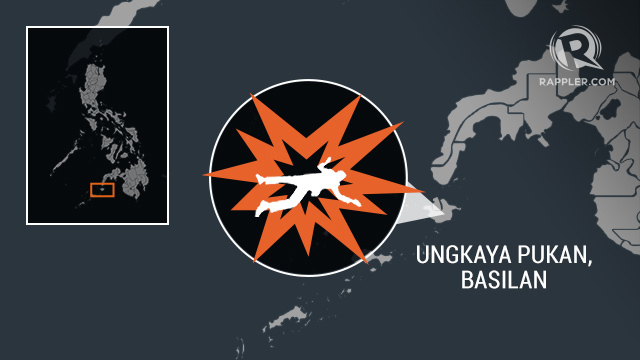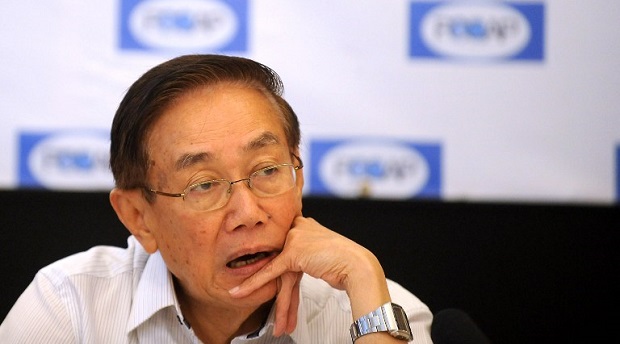From InterAksyon (Jul 29):
Shock & Awe in the 15th Century: China's 27,000 sailors, 300 ships, 7 voyages (Part 2 of 4)
 China coast guard blocks Philippine supply ship, 30 March 2014. AFP FILE PHOTO
(Editor’s note: In view of the presentations made by the Philippines before the UN arbitral tribunal on the country’s suit against China regarding the West Philippine Sea territorial dispute, key aspects of China’s history can help produce insights into the dynamics of the rising superpower’s possible future relations with its neighbors, specifically the Philippines. Author Cesar Polvorosa Jr. is a business school professor of economics, world geography, and international business management in Canada. He is also a published writer in economics, business, and literature.)
Read Part 1 of 4, ‘21st Century will be the Pacific Century’ here.
China coast guard blocks Philippine supply ship, 30 March 2014. AFP FILE PHOTO
(Editor’s note: In view of the presentations made by the Philippines before the UN arbitral tribunal on the country’s suit against China regarding the West Philippine Sea territorial dispute, key aspects of China’s history can help produce insights into the dynamics of the rising superpower’s possible future relations with its neighbors, specifically the Philippines. Author Cesar Polvorosa Jr. is a business school professor of economics, world geography, and international business management in Canada. He is also a published writer in economics, business, and literature.)
Read Part 1 of 4, ‘21st Century will be the Pacific Century’ here.
An integral myth on China is the supposed moral exceptionalism of the country among the great powers. China was after all
Chung Kuo the Middle Kingdom and historical China was “a shining civilization in the center of All-under-Heaven radiating a splendid and peace-loving culture” (Yuan-kang Wang, The Myth of Chinese Exceptionalism, Foreign Policy, March 6, 2012). China is a benevolent power as it did not acquire overseas colonies as the Europeans, the Americans, and the Japanese did - in fact, at critical periods, they subjected the country to unequal treaties. The century before the 1949 Communist takeover was known as the “Century of Humiliation.” The worldview of this oppression of the Chinese especially in modern times by the Japanese and Westerners is for instance, a common theme in
kung fu movies.
Indeed, in the past few centuries as Western imperialism subjugated entire continents China was largely a “benevolent” power that did not actively interfere with its neighboring countries such as the Philippines. Is it from a state policy of peaceful coexistence with its neighboring countries? So why didn’t China create an overseas empire in the European fashion?
Conquest of Asian mainland is part of ancient history
China is primarily an Asian continental power. It expanded from its core region of the
Huang He or Yellow River which was the ”Cradle of Chinese Civilization” and one of the original cultural hearths of the world. As it expanded it conquered non-Han nations (i.e. non-Chinese) but this was so ancient that it has drifted to present irrelevancy and oblivion. This is unlike the US whose westward expansion and conquest of native tribes was relatively recent that it was well documented and continues to be polemical. European powers by the time of the Renaissance had no viable frontiers except to venture out into the Atlantic. Just the same, the ramifications of Chinese empire building in mainland Asia continue to reverberate to the present day.
Tibet had been independent for centuries but by the 1700s was controlled by Qing China, and incorporated by the People’s Republic in 1950. The Dalai Lama fled to India during the 1959 Tibetan rebellion. Thus, there are active Tibetan groups opposed to the present Chinese rule.
Xinjiang is the huge, mountainous, and desert region in the northwest frontier of China. The region’s population of Uyghurs and Kazakhs have cultural affinity with Central Asia rather than with Han Chinese. Some Uyghurs are struggling for independence which has caused tension and ethnic strife in Xinjiang.
Vietnam was a Chinese province for over a millennium. The Vietnamese gained independence after defeating Imperial China in a decisive battle. Thus, the struggle against China was also instrumental in forming Vietnamese national identity and provides context to their strident opposition to the Chinese saber rattling in the region.
Taiwan came under Chinese rule in the 1600s. The Spaniards were apprehensive that Chinese General Koxinga would invade the Philippines; this was only averted by his death. The expansion trajectory of China suggests that if the Philippines was not a Spanish colony, the Chinese would next gradually colonize Luzon. Then China lost the 1894 war to a rapidly modernizing Japan and the latter consequently occupied Taiwan.
Chinese settlements of course are found in various sites in Southeast Asia (e.g. Sangley Point) but as the country gradually declined after the 1600s, their expansion were constrained by the European colonizers. National weakness and the presence of European colonizers prevented China from further expansion and possible colonization of maritime Asia.
As a continental power, ancient China alternated between expanding to its natural frontiers and defending against mostly nomadic tribes especially against the Mongols of Genghis Khan in the early 1200s. The Mongols established the Yuan dynasty and China under the reign of Kublai Khan would invade Japan twice. The failures of the invasions profoundly influence Japanese history and beliefs though the burning issue had been on the Japanese invasion of China because it was more recent. The Manchus then invaded China and established the last imperial dynasty, the Qing Dynasty (1644- 1912).
With their concentration on the Asian mainland, Chinese naval and maritime technology relatively lagged behind until after the millennium. Then it would flourish and lead the world and for a brief interlude during the voyages of Admiral Zheng He, Chinese imperialism would be on full display when it had the resources and opportunity to do so.
Admiral Zheng He’s gunboat diplomacy preceded the Europeans by centuries
A century before Magellan and the European Age of Exploration, China assembled an impressive fleet of more than 300 treasure ships, battle junks, and supply ships manned by 27,000 sailors, soldiers, and crew led by Admiral Zheng He. By all accounts, the Chinese treasure ships were more technologically sophisticated and several times bigger than the Spanish galleons that were to sail a century after.
This was 15th century shock and awe: The massive fleet projected stunning Chinese might into the coastal regions of Southeast Asia, Bay of Bengal, Indian Ocean (Ceylon and the Malabar Coast of India), Saudi Arabian peninsula (Yemen), and East Africa. This would be the modern day equivalent of Nimitz class super carriers (or the newest Gerald R. Ford class) accompanied by Zumwalt destroyers, littoral combat ships, amphibious assault ships, and numerous supply cargo ships making port calls.
While there is a debate among scholars ranging from the “proto scientific” argument of Joseph Needham that the voyages’ main purpose was to collect rare materials and scientific knowledge, the evidence is more supportive of Robert Finlay’s (and Yuan-kang Wang’s) argument that Admiral Zheng He implemented the militarist ambitions of the Yongle emperor (The Voyages of Zheng He, The Journal of the Historical Society, Sept. 2008). The fleet’s seven voyages were not primarily for exploration as they traversed mostly old trading routes. This was intelligence gathering and a demonstration of China’s strength. It sought to establish trading posts along the sea routes which as the Europeans would manifest centuries later became the prelude to invasion and colonization.
In the course of the voyages, Zheng He’s naval force invaded and defeated Alekaswara’s Kotte Kingdom of Ceylon (Sri Lanka) in 1411. The fleet routed Chen Zuyi's pirate fleet and Sekandar's forces both in Sumatra bringing security and stability to the region through Chinese control. Although the Chinese intervention was supposedly welcomed in official accounts, these engagements were unequivocal demonstrations of the formidable military power of Ming China to the countries of Southeast Asia and the Indian Ocean.
The expeditions showed that if China had the military capability, it will not hesitate to use them even in the distant Indian Ocean. How much more then will China not hesitate to use its military force in its own backyard, in the West Philippine Sea in disputed territory that it explicitly claims as its own and with 21st century naval and military technology and firepower? How different is this from US military intervention during the past century in many small countries including the Philippines?
Zheng He’s expeditions were a remarkable achievement but they also constituted an early use of gunboat diplomacy, which is the pursuit of foreign policy objectives with the aid of conspicuous displays of naval power - implying or explicitly becoming a direct threat of military force should terms not be agreeable to the superior force (Cable, James, Gunboat Diplomacy, Institute of Strategic Studies). As historians observe, Zheng He’s massive and powerful fleet would have been a terrifying sight as it appeared on a country’s shore. This was centuries before the Europeans would use gunboat diplomacy as an instrument of foreign policy.
After the death of Admiral Zheng He in 1433/1435 the treasure ships voyages ceased. The Mongols threatened once more China’s stability. But even after the Mongols passed on to historical obscurity, the Chinese never ventured out again to explore the oceans in such strength. Apparently, the conservative Confucian scholars who disdained the pursuit of commerce won over the innovative, forward-looking eunuch faction (Zheng He was a eunuch) in a power struggle.
Internal conflict
This battle for supremacy over the policy course of China represented wild swings of the pendulum between modernity and tradition, openness and insularity, soft power vs. hard power, and would periodically plague China in the centuries to follow including the present generating disruptions and discontinuities.
Alternative scenarios of historians and economists speculated on the consequences on the world had China not pursued an isolationist policy after the era of Zheng He. Ming China to early Qing marked the zenith of Chinese civilization before the country would rise again in the present era.
If China's massive fleets continued their explorations they, instead of the Europeans, would have colonized the Americas. China would have dominated the world for the past half millennium. Instead, China turned inward and gradually became decrepit that accelerated in the tumultuous 19th century.
Meanwhile, the western powers rapidly industrialized and modernized. In its own vulnerable moment, China became easy prey for the Western powers especially from the mid 19th century.
China was humiliated by the western Gunboat Diplomacy where it was forced to open more areas of the country to foreigners in unequal port treaties. Thus, with Chinese defeat in the Opium War, Hong Kong became a British colony.
Japan also would succumb to the Gunboat Diplomacy of the West when it ended its isolation after Commodore Perry (not Dewey, as earlier posted) forced open the country in 1853-1854. Unlike China, which was locked in prolonged power struggles between the conservatives and the progressives, the Japanese quickly realized the advantages of Western technologies and adopted them to modernize the army and navy. By 1894, Japan would defeat China and become like the other Western powers participating in the division of the “Chinese melon.”
Read Part 3 of 4, ‘China following US capitalist footsteps and its various implications’, on Sunday, August 2.
Read Part 4 of 4, ‘Internal conflicts that pull Chinese actions in many directions’, on Wednesday, August 5.
http://www.interaksyon.com/article/115061/shock--awe-in-the-15th-century-chinas-27000-sailors-300-ships-7-voyages-part-2-of-4














